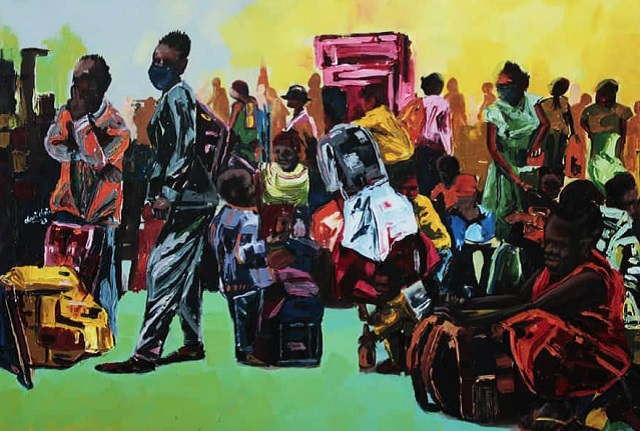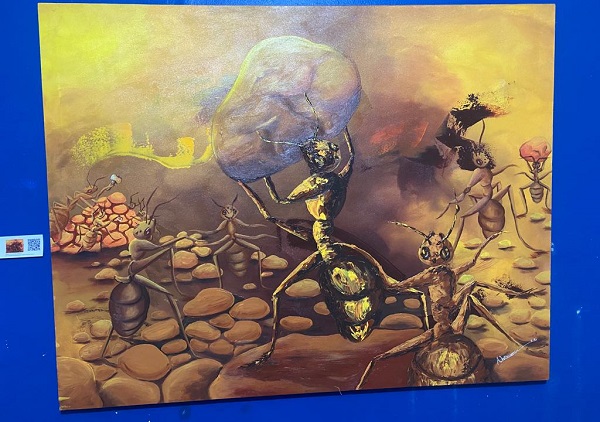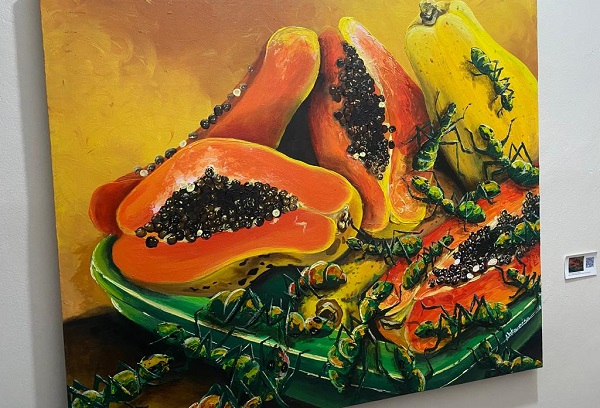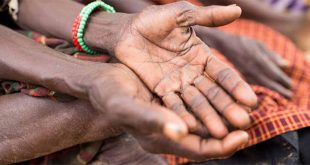
Student- artists provoke conversations on the social political ills in their immediate communities
Kampala, Uganda | DOMINIC MUWANGUZI | What is the role of art in a society filled with so much strife? Can art contribute to the idea of problem solving through shedding light to society’s ills? The answer to these intrinsic questions is aptly answered in the paintings that are on showcase at Tadooba gallery in a group exhibition titled Stirred Chronicles. In this exhibition, the primary objective of the artists is to provoke conversations on what is happening within their immediate surrounding. Therefore, there is deliberate choice of concept and subject matter by the artists to trigger the attention of the viewer. Such intentional approach is guided by research where the artist delves deep into the type of imagery they deploy on canvas inorder to construct a strong visual language for their art.
Nakaweesa Rebecca chooses to work with the concept of ants. Ants are obviously known to be communal insects which live in large communities. Because they live together, they work together to achieve a common good. The artist’s choice of ants as a recurring motif in her paintings is intended to conjure such a narrative of communal living. As soon as the viewer interface with the subject of ants on canvas, they are immediately reminded of their natural instinct to work together.
The artist’s technique of contextualizing the natural traits of ants to the traditional African setting stimulates conversation on the nature of modern society. Modern society propagates individualistic ideals and practices that greatly compromise on the communal practices of African traditional society. Here, the artist builds the argument that many of the problems we encounter today, are as a result of frowning upon the concept of communal living. Unlike the ants which we all know live in large groupings and work collectively, we human beings are selfish and prejudiced. The artist’s artistic ploy to dramatize the ants through making them perform human roles, underscores her message. Similarly, the studio technique infuses in the work qualities of intrigue and suspense thereby providing an enduring appreciation of the art.

Such interrogation is palpable in the paintings of Ochepa David Peter which offer a critical insight into leadership and how power and authority that emanate from leadership is used in modern society. The artist selects the Buffalo as an allegorical representation to the theme of leadership. The buffalo with its short but sturdy horns; resting like a crown on its head; depict an image of one in authority. Little wonder, the animal commands respect among other animals in the wild because of its size and fiery look. Through the figurative interrogation, the artist variously depicts the head of the Buffalo dressed on different personalities including a police officer. The depiction of the police officer draped in a Buffalo’s head will instant raise a lot of attention to the public. This is because of the kind of reputation the Police force holds out to the public vis `a vis the character of one of the fiercest beasts in the wild.
In Uganda in recent times, the Police institution has encountered a barrage of criticism from the citizens in the manner in which it uses its authority. Like the Buffalo, which uses its boisterous demeanor to fiercely attack its victims, the Police uses the authority bestowed upon it to keep law and order, to otherwise brutally confront and subdue the citizens. Such allusion, clearly exposes the extent at which the State misuses its position of leadership. The artist’s forte to incite intellectual discourse- intellectual because he deliberately creates his work to deeply engage the mind of the viewer- in his art is witnessed other painting like Kazooba, Thinking in Colour and Silence Influence. Still working with the concept of the Buffalo’s head, the artist here engages us farther to reflect on the subject of leadership in different spectrums of society.

While Ochepa impresses us with his intellectualism and Nakaweesa enthralls us with the imagery of ants responding to the subject of communal living, Bwire’s concept of Street Life with Street children as a major subject staring at us with empty eyes and filthy clothes instantly arrests our emotions. The street children in the paintings represent neglect, resentment, and desperation which street life is synonymous with. Nonetheless, instead of conveying a message of hopelessness for the children, the artist paints the children at work. They are depicted selling food in the market, picking scrap and as Matatu conductors. The depiction of these destitute children as workers, evokes a narrative of resilience in the paintings. Albeit, their unfortunate circumstances they are determined to make a living for themselves.
Through providing a critical lense on what is happening in their immediate surrounding, the artists provide an essential avenue to address the social- political ailments of modern society. It is through such conversations, that citizens can subvert the misuse of political leadership or petition local leadership to rally people to work together for the benefit of an equitable society.
*****
The Exhibition by Art students of Kyambogo University is showing at Tadooba gallery located in Nangwa-Butwalo, Mukono. The exhibition is showing for a month.
 The Independent Uganda: You get the Truth we Pay the Price
The Independent Uganda: You get the Truth we Pay the Price



